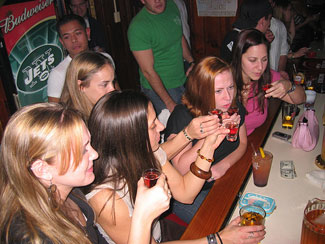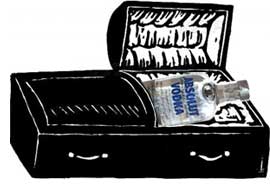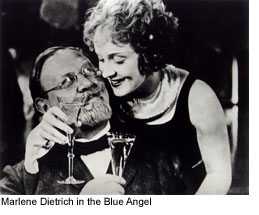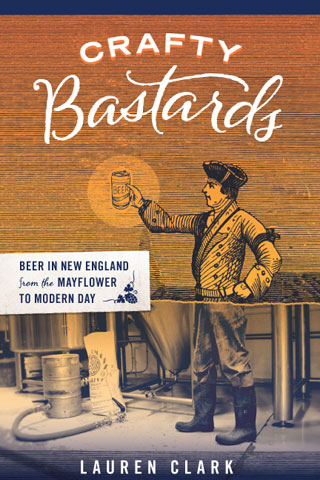Archive for the ‘Vodka’ Category
March 22nd, 2008

Some interesting items came over the transom this week that had to do with the supposedly specialized booze preferences of women. First, reader Adam M. pointed me toward a Reuters article about a new Russian vodka, Damskaya, or “ladies’ vodka.” The vodka is being “touted as a glamour product for upwardly mobile women in booming Russia,” and its ads “show the elegant, violet-tinted bottle wearing a pleated white skirt which is blown upwards to reveal the label.” Wow. What says “glamour” more than a purple vodka bottle wearing a skirt?
Next, the Ladies of LUPEC Boston told me about a post on the Thinking of Drinking blog called Gender Specific Cocktails? The blogger, Sonja Kassebaum, a Chicagoan who co-founded the North Shore Distillery, writes, “Do most women really only like the fruity, sweet (and/or light) cocktails? Even if that were true, is that because that’s really their preference, or is it because of how spirits have been marketed to them, and/or because of a lack of education & experience with other choices?”
I argue that it’s the latter. Women’s alleged preference for “girly drinks” has at least as much to do with marketing (hello, Damskaya!), education and peer influence as with actual taste. I mean, if the palate is really as gender-determined as drinks marketers imply, then the women who make up a large chunk of the audience for fine wine — a complex, generally non-sweet beverage — are genetic freaks. As are the growing number of female drinkers who, like me, appreciate vintage, “grown-up” cocktails layered with the flavors of whiskey, vermouth, gin, bitters and classic liqueurs.
Which brings me to an article by the Wall Street Journal’s Eric Felten that was published a couple of years ago, “He Drinks, She Drinks.” Anyone seeking a thoughtful analysis of gender stereotypes at the bar should read this. Felten writes:
“Girly drinks limit men and women both. Women get lulled into the habit of drinking cocktails that don’t taste like, well, drinks. And for men, it’s even worse: In their haste to avoid anything that smacks of the emasculating girly-drink taint, they deny themselves the great adventure of exploring cocktails in all their variety. They’re both missing out. The recent revival of interest in classic cocktails presents a long-overdue opportunity to break out of the tyranny of the girly, giving men the freedom to order mixed drinks without shame and women the chance to order drinks worthy of grown-ups.”
“The tyranny of the girly!” Yes, we are all under the well-manicured thumb of the collective Cosmo drinker. But classic cocktails will set us free! Gender stereotypes at the bar will be crushed! That is, as soon as articles like Felten’s start appearing in publications whose readerships aren’t dominated by men.
Posted in Booze in the news, Vodka | 2 Comments »
September 8th, 2007
 Man, I have really dropped the ball. It has been over a year since I dissed vodka. It’s time, then, for part 3 of drinkboston’s Vodka R.I.P. series. In part 1, I talk about how the ubiquity of this colorless, flavorless spirit has dumbed-down mixology. In part 2, I investigate how this state of affairs came to be. Here, I present evidence that knocks vodka down a few more pegs.
Man, I have really dropped the ball. It has been over a year since I dissed vodka. It’s time, then, for part 3 of drinkboston’s Vodka R.I.P. series. In part 1, I talk about how the ubiquity of this colorless, flavorless spirit has dumbed-down mixology. In part 2, I investigate how this state of affairs came to be. Here, I present evidence that knocks vodka down a few more pegs.
I know, I know. You’re a bartender, and you’re saying, “I have to keep my customers happy! Vodka’s what they want to drink. If I put a bunch of gin and whiskey cocktails on my menu, people will freak. That stuff scares them.”
Here’s something that’ll scare them even more, or at least kill their buzz:
“Achieving the ‘purity’ so essential to the spirit is almost impossible on an artisanal pot still. Making pure ethanol is what industrial stills do best, which is why two of the … major players producing vodka in the U.S. are Archer-Daniels-Midland and Grain Processing Corp. of Muscatine, Iowa. ADM sells its 190-proof beverage alcohol (product code 020001) packaged one of three ways: ‘Bulk Truck, Bulk Rail, Tank.’ Cut it with water … bottle it, and you’re in the vodka business,” writes Eric Felten in the Wall Street Journal (“Make Mine a 020001,” 9/1/07).
Bulk Truck! That’s going to be the name of my new premium vodka. Does it get any more obvious that the path from America’s largest agricultural processor to a $40 bottle of Grey Goose is paved with marketing wiles and consumer gullibility? Bartenders, if a vodka-drinking customer remains unfazed by this fact and says, ‘Who cares? I like the smooth taste of Brand X,’ you might run another Felten tidbit by him:
“I went to a vodka tasting hosted by the head of a prominent luxury liquor house. After being walked through the vodkas on the table with elaborate descriptions of the characteristics of each, I found myself hard-pressed to discern much difference. So I asked the executive to demonstrate the differences by tasting the vodkas blind. He couldn’t even identify his own flagship brand.”
I’m not saying that some gins, rums, tequilas and other big-name “premium” spirits aren’t produced in industrial quantities. But they aren’t as dependent as vodka on high-falutin’ claims of purity and sophistication. They have distinguishable flavors that come from their base ingredient, i.e. sugar cane or agave, or from botanicals like juniper, or from barrel aging. Vodka doesn’t. Claims of purity and sophistication are all it has. And now that the vodka market is so crowded, marketers are trying to set their products apart by, for example, touting earth-friendly distillation methods and packaging (360 Vodka) or organic ingredients (Square One Organic Vodka).
One way that vodka makers have been trying to wring money out of the category for years now is through flavors. You know, vanilla, raspberry, orange (or “oranj” if you’re Stoli — ooh, such stylish spelling!), etc. I recently sat down with a PR woman for the Van Gogh vodka brand at the South End bar 28 Degrees. She gave me samples of several Van Gogh vodkas, including pineapple, acai-blueberry, chocolate and espresso. She wanted to know what I thought of them. I told her that the flavors were authentic enough — the pineapple tasted like pineapple, the espresso tasted like espresso — but that they were not at all interesting for someone like me, who actually enjoys the taste of spirits and seeks out drinks whose ingredients form an actual Cocktail, as opposed to something that merely mimics another food or beverage.
On occasion, people say to me something like, “So I have a pomegranate vodka martini and I enjoy it. So what? No one gets hurt.”
Right, no one gets hurt. Except for the people who are desperately seeking a drink that tastes like a drink and not like a dessert or a cup of coffee or a glass of fruit juice. And with a lot of vodka mixology, you’re lucky if you get even that. The one cocktail that I sampled at 28 Degrees, the Prosciutto and Melon, was not even as mildly pleasant as I thought it would be. I was imagining a drink that tasted like spiked fresh cantaloupe. Instead, the drink tasted strangely metallic. And the kicker was the garnish. The strip of prosciutto that was wrapped around the ball of melon left little beads of animal fat floating atop the puréed cantaloupe-melon vodka mixture. Ick. Is this really the sort of drink people want to pay $12 for?
Posted in Boston bars, Cocktails, Vodka | 20 Comments »
April 25th, 2007
 LUPEC invaded my home last night — and it was good. The Boston chapter of Ladies United for the Preservation of Endangered Cocktails launched a few months ago and has already created cocktails for and otherwise helped promote several local benefits, like the Operation Frontline Dinner at Tremont 647 and the Taste of the South End. Every month, the Ladies get together for a cocktail party celebrating a theme of the hostess’ choosing. Last night’s theme was Drinkin’ Dames in Classic Cinema, and several attendees dressed for the occasion in polka-dot blouses, pillbox hats, fishnet stockings and Mary Jane pumps. I am proud to say that these discerning tipplers approved of the five dame-influenced cocktails I served.
LUPEC invaded my home last night — and it was good. The Boston chapter of Ladies United for the Preservation of Endangered Cocktails launched a few months ago and has already created cocktails for and otherwise helped promote several local benefits, like the Operation Frontline Dinner at Tremont 647 and the Taste of the South End. Every month, the Ladies get together for a cocktail party celebrating a theme of the hostess’ choosing. Last night’s theme was Drinkin’ Dames in Classic Cinema, and several attendees dressed for the occasion in polka-dot blouses, pillbox hats, fishnet stockings and Mary Jane pumps. I am proud to say that these discerning tipplers approved of the five dame-influenced cocktails I served.
Ginger Rogers
1 oz dry gin
1 oz dry vermouth
1 oz apricot brandy
4 dashes lemon juice
Shake well over ice and strain into chilled cocktail glass. The liquid equivalent of Ginger floating elegantly in a feathered gown.
Barbara West
2 oz dry gin
1 oz dry sherry (Amontillado works well)
1/2 oz lemon juice
1 dash Angostura bitters
Shake well over ice and strain into chilled cocktail glass. Lemon twist. Thanks to Ted Haigh for resurrecting this excellent aperitif cocktail. (Who the hell was Barbara West? No one knows. When serving this drink, make up your own story about her.)
Roman Holiday
1 1/2 oz vodka
1/2 oz Punt e Mes
1/2 oz sweet vermouth
splash of fresh orange juice
Shake well over ice and strain into chilled cocktail glass. Thin orange slice. Refreshing!
Ann Sheridan
1 1/2 oz Myers dark rum (recipe called for Bacardi dark rum; other recipes call for Bacardi light rum)
1/2 oz orange curacao
1/2 oz lime juice
Shake well over ice and strain into chilled cocktail glass.
Marlene Dietrich
2 oz rye whiskey
1/2 oz orange curacao
2 dashes Angostura bitters
Shake well over ice and strain into chilled cocktail glass. Lemon twist and flamed orange peel. (OK, I took liberties with the original recipe, which called for 3/4 wineglass (!) of rye and only two dashes of curacao. A lightly adulterated glass of rye was probably just right for Marlene, but I wanted a little more balance.)
Posted in Cocktails, Gin, Rum, Vodka, Whiskey | 8 Comments »
August 24th, 2006
 Continued from part 1.
Continued from part 1.
It’s not that I shun vodka entirely. What else am I going to put in my Bloody Marys? I don’t get all huffy when I order a Martini and the bartender asks, “Vodka or gin?” Vodka’s a fact of life. I’m cool with it. Hell, I stock it in my bar at home and serve it at cocktail parties.
What I’m not cool with is that eight out of 10 drinks on most cocktail menus around Boston are vodka-based. These menus offer what appears to be a great variety of options, which is true if you’re looking for one-dimensional fruit and candy flavors. Where are the more complex, more adult mixed drinks? Where is the whiskey, the gin, the vermouth, the Benedictine? They’re behind the bar alright, but few bartenders know how to make cocktails with them (the few who do are among Boston’s best bartenders, of course).
Vodka’s dominance reminds me of the beer market 25 years ago. The only beer style available was light lager, be it Bud or Heineken. Classic styles like India pale ale and stout were relics of pre-Prohibition days or the Old World. The emergence of craft beer and the growth of imports changed that. Now, when you go out drinking in Boston, any two-bit bar has, at the very least, Harpoon, Guinness, or Sam Adams on tap. Bud is still king (and still really good ice cold out of the can), but it and its pale, fizzy brethren are no longer our only options, thank god.
How did vodka come to drown out other spirits? When a new “cocktail culture” emerged in the early to mid-nineties (Remember? You bought a few of those lounge compilations Rhino Records put out?), it might have seemed to cocktail connoisseurs that everyone would soon rediscover vintage mixtures like Sazeracs and Hemingway Daiquiris. No such luck. In Vintage Spirits & Forgotten Cocktails (2004) Ted “Dr. Cocktail” Haigh offers a colorful scenario of what went down:
“A food and beverage manager (hypothetically) says: ‘This new generation of drinkers…are nostalgic for their vision of the 1950s martini parties they’ve seen in old movies…Only problem is, it’s likely none of this crowd has actually ever had a real martini, and I bet if they did, it would knock ’em on their ass. WAY too strong. They’d run away screaming. So I say this: let’s mix a little vodka and some liqueur, shaken and strained in a stemmed cocktail glass, and call it a fill-in-the-blank Martini.'”
Enter the Cosmopolitan, the poster child of the modern cocktail. Thanks to Sex and the City, this insipid pink drink (vodka, orange liqueur, splash of cran) reached an undeserved level of fame and inspired many spinoffs. It was like Paris Hilton in a glass.
Finally, there was the explosion of vodka brands on the market. There are, like, 92 varieties of vodka on the shelf of a typical liquor store. Their sleek, frosted bottles evoke purity and sophistication, which appeals to a lot of people who a) had a bad experience with tequila in college and believe that vodka’s somehow better for them, and b) think that ordering a “Goose, rocks,” in a bar makes them look cool.
It’s inescapable: vodka is everywhere, and its popularity isn’t going to die down anytime soon. But there are rumblings that drinkers are looking for something new. And just as microbrews came to the rescue of beer drinkers looking for bolder flavors 25 years ago, some bartenders are rebelling against the blandness of “fill-in-the-blank Martinis” by reviving forgotten recipes for truly sophisticated drinks — call them craft cocktails — and people aren’t running away screaming.
Stay tuned for part 3.
Posted in Boston bars, Cocktails, Vodka | No Comments »
July 28th, 2006
This is a vodka drink I can get behind. That’s because there’s gin in it. And because James Bond invented it. (OK, Ian Fleming invented it.) In Casino Royale, the terrific first 007 novel, Bond demonstrates that he is both a man of taste and a man who knows exactly what he wants with this drink order: “in a deep champagne goblet … Three measures of Gordon’s, one of vodka, half a measure of Kina Lillet. Shake it very well until it’s ice-cold, then add a large thin slice of lemon peel.” He names the drink after his gorgeous, dark-haired, enigmatic colleague, Vesper Lynd, whom he discovers is a double agent after she commits suicide in despair over their doomed love. Not surprisingly, Bond never re-visits the drink in subsequent novels. But that doesn’t mean that non-fictional drinkers the world over can’t enjoy it. It’s so Bondian: cool, subtle, hard-edged. The Independent in Somerville’s Union Square is, as far as I know, the only place in greater Boston that lists the drink on its cocktail menu. Naturally, the bartenders use English dry gin (Beefeater) and Bond-approved Russian vodka (Stoli).
Posted in Boston bars, Cocktails, Vodka | 1 Comment »

 Man, I have really dropped the ball. It has been over a year since I dissed vodka. It’s time, then, for part 3 of drinkboston’s Vodka R.I.P. series. In
Man, I have really dropped the ball. It has been over a year since I dissed vodka. It’s time, then, for part 3 of drinkboston’s Vodka R.I.P. series. In  LUPEC invaded my home last night — and it was good. The
LUPEC invaded my home last night — and it was good. The  Continued from
Continued from 